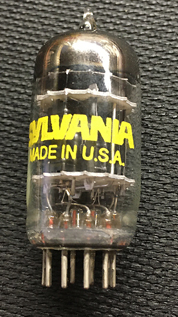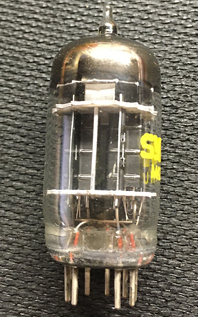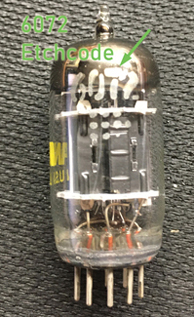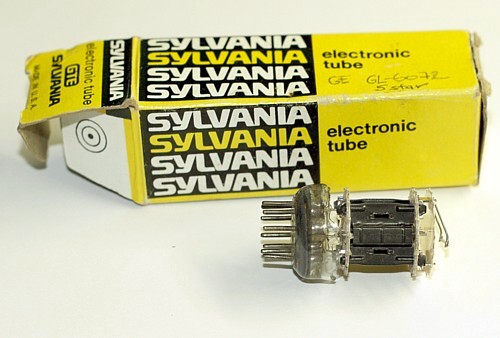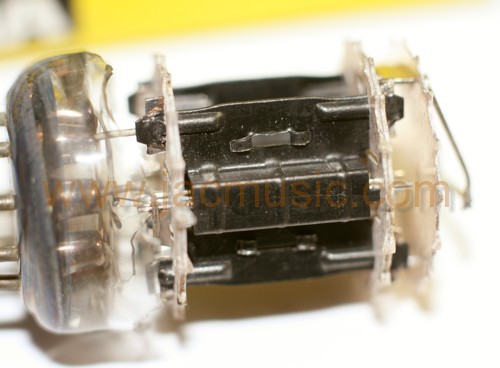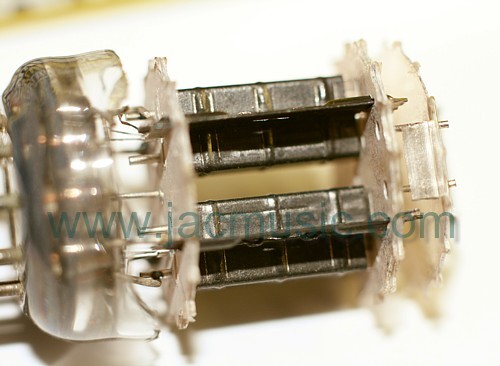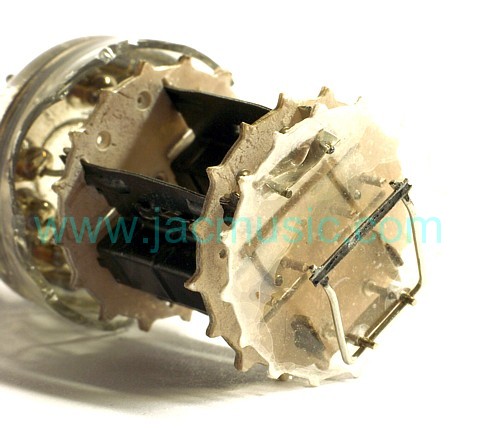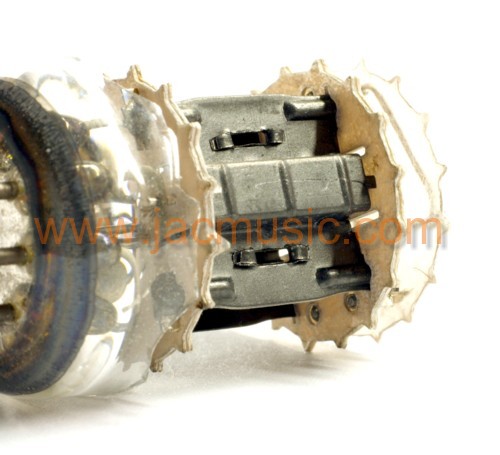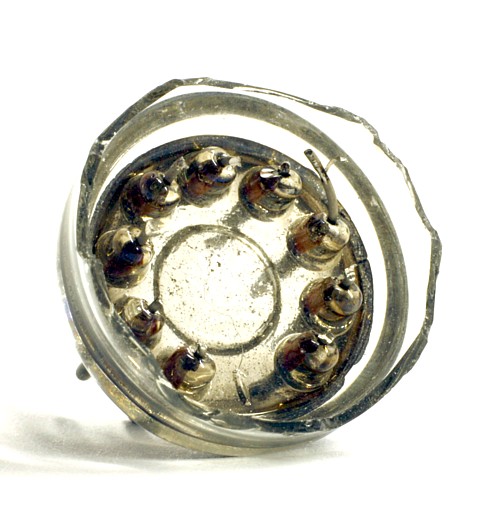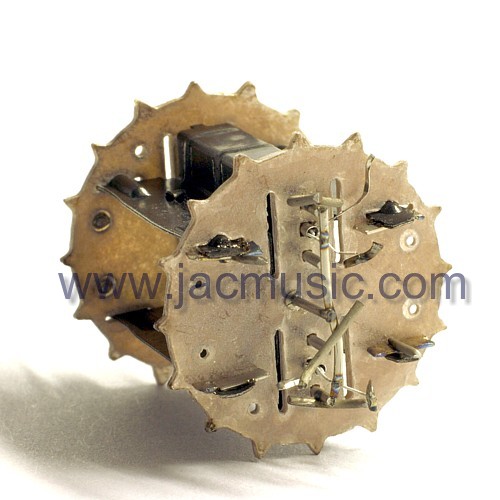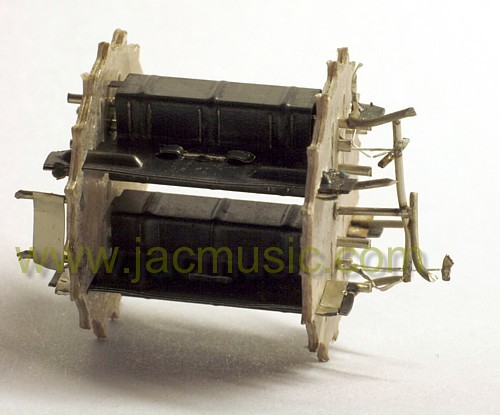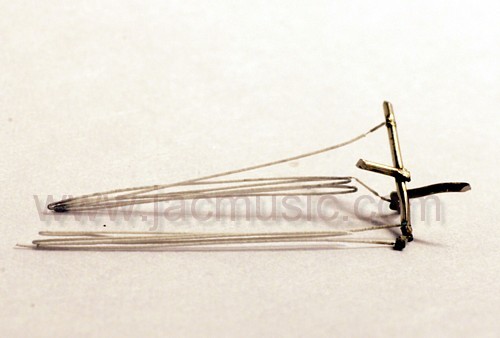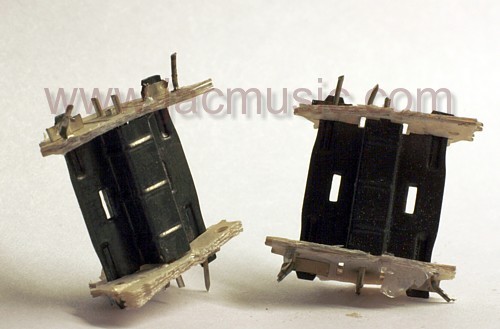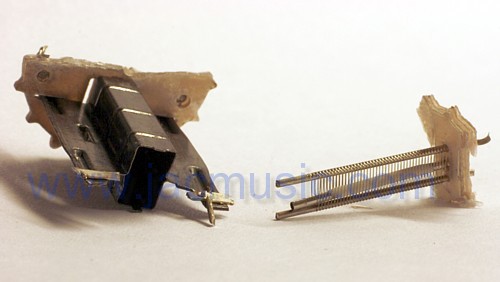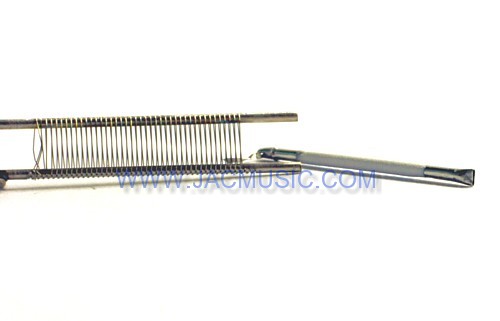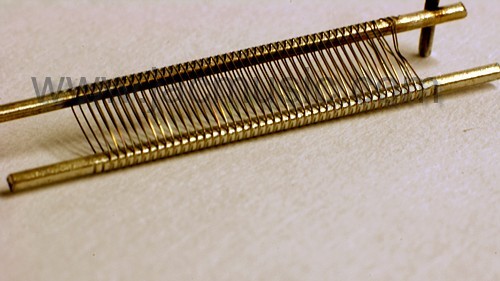Portrait of a Tube
6072 / 12AY7
 12AY7 is a not so well known member of the 12A..7 series of twin triodes. Sorted by gain here, this family members are: 12AU7, 12AY7, 12AT7, 12AX7. Each is specialised on a special function. As my late friend Roger Modjeski always pointed out, the best design always results from using the tubes the INTENDED way. Roger based his entire product portfolio on this philosophy, being contrary to what newcomers sometimes like to do. Some think the more "interesting" a circuit looks, the better it sounds. Only to find out, those old tube designers were not stupid.
12AY7 is a not so well known member of the 12A..7 series of twin triodes. Sorted by gain here, this family members are: 12AU7, 12AY7, 12AT7, 12AX7. Each is specialised on a special function. As my late friend Roger Modjeski always pointed out, the best design always results from using the tubes the INTENDED way. Roger based his entire product portfolio on this philosophy, being contrary to what newcomers sometimes like to do. Some think the more "interesting" a circuit looks, the better it sounds. Only to find out, those old tube designers were not stupid.
So not say, I need a gain of 25...50, so I could use 12AU7, 12AY7 or 12AT7. That is only true if distortion, noise, plate impedance and maximum signal level play no role for your application.
Really good are hard to find. 12AX7 was always expensive. From the days where it could be bought new in the radio shop, until today as NOS. 12AT7 was really cheap per 100 in the late 90's, but even with this tube, buyers become pickery, which means the market gets thinner. Something similar applies for 12AU7. 12AY7, where this article is is about, is a bit unuseual. It was never widely used in a great number of commercial products, so NOS stocks are low, very low everywhere. Today it is used by few manufacturers in retro products. So it's kind of a fragile market, with relatively high prices for very nice tubes.
The GE "five stars" tubes are rare. Like when only 0.1% of the NOS tubes is five stars, that is one out of 1000 tubes. At just 10% price adder, everybody would grab for the five stars Series. Probably at 2x the price as well. That is why such are 10x more expensive rather. As a proof for sellers, price and demand is balanced when such items do not sell immediately for the asking price. If you do not know, what exactly is the five star series, the WRONG place to look is the internet opinions. The right place to look, is the manufacturer data sheet. Believe it or not... they put that on paper. So what it says there, is facts.
This is the situation with all 12A..7 tubes:
12AT7: Excellent standard tube. High gain, high plate current. A lot of NOS is for sale. Easy to find and not expensive. E81CC, 6201 are the better versions, with lower noise, longer life, some have gold pins etc. They may easily cost 3x more. Though noise is perhaps just a little bit less and not 3x less. ECC801S is a balanced tube, per data sheet. And only 1 of 10000 NOS tubes may be an ECC801S. Very few are Telefunken, and not all Telefunken have a diamond.
With 12AX7 the situation is another. Not as many were made, but these were used often in applications for high gain, and along with gain comes always noise. So any low noise types, virgin tubes, finest brand, NOS, new in the box, these are really expensive.
12AY7 is the low noise tube, high gain tube from this family, and even less were made than 12AX7. At least 12AX7 was a commercial tube, but 12AY7 was found in few products only. Even rarer was the 6072. This may sound unexpected, but really, the best place to read about tubes, is such a boring document like a data sheet, and not forum babble.
6072. Let me quote from the RCA 6072 data sheet:
- "For use in industrial and military applications, critical as to microphonics, and in which dependability is paramount".
- "Shock Rating: 600g". Do you know what that means? It means an item of 50 gram, impacts with a weight of 30kg.
- Fatigue rating. "2.5g applied for 100 hours with 25 Hz".
- Heater Cycling: "2000 cycles". But not just that, they specify that at a heater if 7.5 Volts. So that is 19% (!!) too high.
CV4068 / 6158 / 13D3
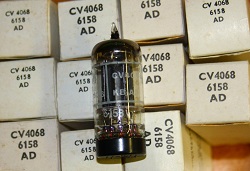 CV4068 is the British military specification for an 6158 with extra testing. Already 6158 is a high reliability tube for critical applications. These tubes comes somewhere near to 6072. Pin connections are the same. Though this is not a direct replacement for 6072, some people use it as such on their own risk.
CV4068 is the British military specification for an 6158 with extra testing. Already 6158 is a high reliability tube for critical applications. These tubes comes somewhere near to 6072. Pin connections are the same. Though this is not a direct replacement for 6072, some people use it as such on their own risk.
CV4068 British air force data sheet
I read this mess on a forum: (Link here)
'Also, I am unaware of any additional testing (torture test, expected life measurements, whatever) that went into the military version. As far as I know, they are the exact same tube, just labelled JG-6072/JG-6072A/JAN 6072A. GE produced tubes for a number of different clients and the military was no different; they just put whatever brand needed to be printed on the tube. Again, if someone has documented information and not just internet hearsay that counters this, please post and correct me'.
Ok, so he says please correct me. Well let's do that here. This is such a nice example how facts are mixed with hallucinations. He begins with I am unaware of.... That means he knows he doesn't know it. That is ok. Then he continues with what he DOES now. GE produced tubes for a number of different clients. So he says he KNOWS this. I wonder if these clients had names? Next thing he says: the military was no different. Now hold on, he suggests the military buys their stuff there like at any other does. He contradicts himself. exact same tube, just labelled JG-6072/JG-6072A/JAN 6072A. Now he was hallucinating. Reality is like this: JAN Specs is a very difficult and very expensive test method, which I will not explain here in detail. But one of the obligations of the manufacturer was, to keep books about every test result they have. If bad results, they must register what corrective action was done, which names are responsible, and if the corrective action was successful or not. If not, what is the next step, and who will do this by when. And not just that, but the manufacturer must commit to have all this data ready for an unannounced control visit. Meaning at any time the military can show up, and when the documentation is not there, the manufacturer did not comply with regulations. Now you would not want to that General Electric sales person if that happens, and your huge military orders get cancelled. Also being that General Electric manufacturing manager is not the best idea for you career. In the next text fragments he shows he knows not much about it: Again, if someone has documented information. Now am not going to do here, but a simple Google search for original JAN specifications will quickly yield this. Obviously he never bothered. He just posts here things he faintly heard about, but from others he accepts only facts. He writes: not just internet hearsay. Then he says, please post and correct me.
Ok - done!
About the 6072 tube
From General Electric, I see on Ebay both GE6072 and GE6072 ***** can be found.
"Five stars" is a general quality program by General Electric.
FIVE STAR PROGRAM REQUIREMENTS
- Tubes have higher heater current, to avoid burn out
- Gold or silver plated grids
- Set up to withstand Shock and vibration
- Requires a separate factory for these tubes only.
- Requires special (no stress) pay system for the operators.
- Use thyratron welding.
- Inspection must be done by binocular microscope.
- Heater cycling on a daily sample base.
- 50 hours aging.
- Specification of end-of-life ratings.
FIVE STAR Construction REQUIREMENTS
- Bottom and top mica are double for better mechanical stability. (That is four micas)
- Additional getter shield mica at the top (That is the 5th mica) to keep the getter flash away from the functional mica. This mica can be clear (none eliminated) because it has no electrical function. Those double micas (nr 1...4) have more leakage by itself, because they are each two plates attached together. This defines the next requirement:
- Anti leakage construction of mica (extra slots and holes). Which again is possible without compromising the stability, because each is made from two plates. The inner mica however has larger clearance holes, so only the outer mica touches the metal parts of the triode.
- If the heater wire sticks out of the cathode sleeve, the isolation material must be electromechanically removed, to avoid migration of this material inside the tube. Alternatively, the ends can also be additionally plated.
Here is an interesting picture of a special 6SN7 by General Electric for radar applications, showing this in great detail. (I have 8 pcs or so for sale!) WIth this 6SN7, this method results in less welds, and in the end higher reliability. Yet it requires removal of the coating. So the connecting end glows very bright. They might have done so with the five star tubes as well, but what is inside now is probably better.
- Anode cage is shorter, to be more sturdy. (Forget the "long plate" forum babble). This also makes the grid shorter, for lowered microphonics as well.
- Gold or silver plated grid (to prevent grid current, and have better bias stability).
- Connect getter with two welding joints (vibration proof)
- Heater wires first mounted on a bar, and this bar is mounted to the tube bottom.
- Ends of the grids bars are polished, to prevent scratching / sawing of the mica. Such sawing would cause grid rattle and microphonics.
- Some more small details, unlisted here
FIVE STAR General considerations
- Not all tubes have all construction requirements. For instance, such that are meant for lower voltage will not have additional anti-leakage slots, because low voltage tubes don't have that kind of leakage anyway.
- The tubes are dropped in hot water, to detect beginning glass cracks along the pins. Such tubes would basically crack the base diagonally, leading to a white getter.
It should be obvious, the 6072 five star, is an almost ideal candidate for RIAA amplifiers, or and microphone amplifiers. For such applications, users want to reduce the noise at almost any cost.
Some pictures of original SYLVANIA triple mica, black plate
